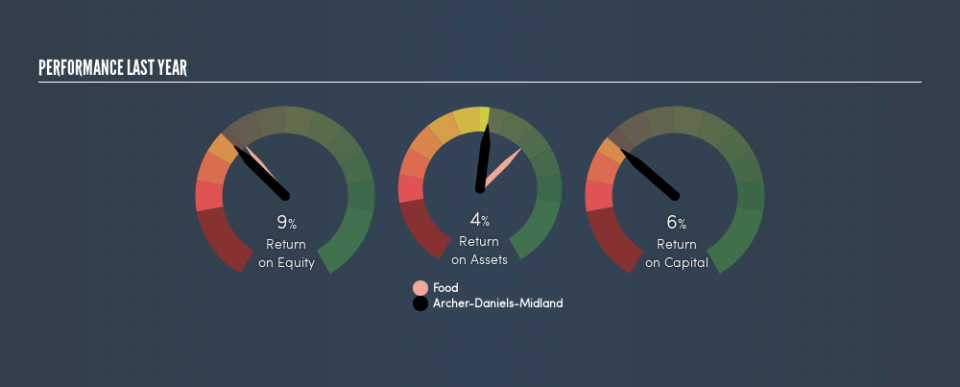Why You Should Care About Archer-Daniels-Midland Company’s (NYSE:ADM) Low Return On Capital

Want to participate in a short research study? Help shape the future of investing tools and you could win a $250 gift card!
Today we are going to look at Archer-Daniels-Midland Company (NYSE:ADM) to see whether it might be an attractive investment prospect. Specifically, we're going to calculate its Return On Capital Employed (ROCE), in the hopes of getting some insight into the business.
Firstly, we'll go over how we calculate ROCE. Second, we'll look at its ROCE compared to similar companies. And finally, we'll look at how its current liabilities are impacting its ROCE.
Understanding Return On Capital Employed (ROCE)
ROCE measures the amount of pre-tax profits a company can generate from the capital employed in its business. Generally speaking a higher ROCE is better. Ultimately, it is a useful but imperfect metric. Author Edwin Whiting says to be careful when comparing the ROCE of different businesses, since 'No two businesses are exactly alike.'
How Do You Calculate Return On Capital Employed?
Analysts use this formula to calculate return on capital employed:
Return on Capital Employed = Earnings Before Interest and Tax (EBIT) ÷ (Total Assets - Current Liabilities)
Or for Archer-Daniels-Midland:
0.061 = US$1.8b ÷ (US$43b - US$13b) (Based on the trailing twelve months to March 2019.)
Therefore, Archer-Daniels-Midland has an ROCE of 6.1%.
Check out our latest analysis for Archer-Daniels-Midland
Is Archer-Daniels-Midland's ROCE Good?
When making comparisons between similar businesses, investors may find ROCE useful. In this analysis, Archer-Daniels-Midland's ROCE appears meaningfully below the 8.3% average reported by the Food industry. This performance could be negative if sustained, as it suggests the business may underperform its industry. Separate from how Archer-Daniels-Midland stacks up against its industry, its ROCE in absolute terms is mediocre; relative to the returns on government bonds. Investors may wish to consider higher-performing investments.
When considering ROCE, bear in mind that it reflects the past and does not necessarily predict the future. ROCE can be deceptive for cyclical businesses, as returns can look incredible in boom times, and terribly low in downturns. ROCE is, after all, simply a snap shot of a single year. Since the future is so important for investors, you should check out our free report on analyst forecasts for Archer-Daniels-Midland.
How Archer-Daniels-Midland's Current Liabilities Impact Its ROCE
Liabilities, such as supplier bills and bank overdrafts, are referred to as current liabilities if they need to be paid within 12 months. Due to the way ROCE is calculated, a high level of current liabilities makes a company look as though it has less capital employed, and thus can (sometimes unfairly) boost the ROCE. To check the impact of this, we calculate if a company has high current liabilities relative to its total assets.
Archer-Daniels-Midland has total liabilities of US$13b and total assets of US$43b. As a result, its current liabilities are equal to approximately 31% of its total assets. Archer-Daniels-Midland's ROCE is improved somewhat by its moderate amount of current liabilities.
Our Take On Archer-Daniels-Midland's ROCE
Unfortunately, its ROCE is still uninspiring, and there are potentially more attractive prospects out there. Of course, you might find a fantastic investment by looking at a few good candidates. So take a peek at this free list of companies with modest (or no) debt, trading on a P/E below 20.
I will like Archer-Daniels-Midland better if I see some big insider buys. While we wait, check out this free list of growing companies with considerable, recent, insider buying.
We aim to bring you long-term focused research analysis driven by fundamental data. Note that our analysis may not factor in the latest price-sensitive company announcements or qualitative material.
If you spot an error that warrants correction, please contact the editor at editorial-team@simplywallst.com. This article by Simply Wall St is general in nature. It does not constitute a recommendation to buy or sell any stock, and does not take account of your objectives, or your financial situation. Simply Wall St has no position in the stocks mentioned. Thank you for reading.


